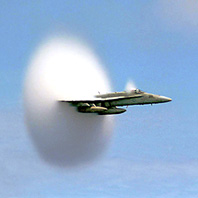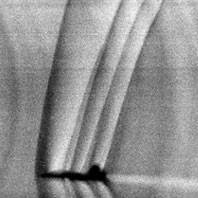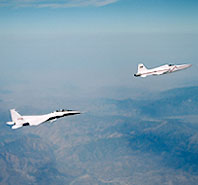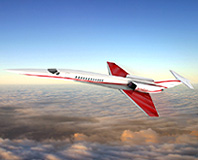|
Is there a way to take the boom out of the sonic boom?
Between 1976, when Concorde began flights to the United States, and
2003, when the aircraft was retired, you may have been fortunate
enough, as I was once, to see Concorde take off. I noticed it from a
distance, while landing at New York's JFK airport in another plane.
But it stood out unmistakably from other nearby aircraft, like a
giant white swan among so many geese and ducks. As it lifted from
the tarmac it did indeed look like a swan rising from a stretch of
still water, its wide-spread wings angled steeply, its distinctive
slender head bent forwards as if unwilling to lose sight of the
Earth even for a moment.
But neither you nor I nor anyone else in the United States ever
caught sight of Concorde in its full glory—that is, flying at
its cruising speed of 1,350 miles per hour, or roughly twice the
speed of sound. That's because, in its quarter century of flying to
America, Concorde was never allowed to fly supersonic, or faster
than the speed of sound, over any portion of the U.S. Other
countries had similar restrictions.
Why? Because of the thunderous sonic boom Concorde trailed behind it
whenever it flew faster than Mach 1, the speed of sound. As much as
Americans embrace speed and convenience, the Concorde's
nerve-jangling bang was unacceptable, especially since most could
never afford to fly it.
Yet the desire for speed and convenience has not gone away. A 1997
National Research Council report stated that the potential market
for a large passenger airliner that can fly supersonically is on the
order of 1,000 jets. And several companies have already announced
plans for smaller supersonic business jets. The challenge for
manufacturers is to figure out how to subdue the sonic boom enough
that the general public will tolerate it and the Federal Aviation
Administration will lift its ban.
 What is a sonic boom?
What is a sonic boom?

Muzzling the boom has everything to do with knowing how it forms.
Every plane pushes air molecules away with great force as it flies,
much as a boat pushes water away. But when an aircraft exceeds the
speed of sound, those molecules can't get out of the way fast
enough, and they begin to pile up around the front and sides of the
plane, like water in a bow wave. This results in a shock wave of
pressurized air molecules, which form a cone-shaped sheath around
and behind the plane.
This cone-shaped shock wave wouldn't be a problem if it lost its
strength as it moved away from the plane. But it doesn't. With
conventional supersonic aircraft, it maintains most of its shape all
the way to the ground. And when that shock wave, traveling at the
speed of sound, sweeps past you on the surface, you hear and feel
the release of the pressure that the shock wave has built up as a
great BOOM-BOOM. (The double boom occurs because the various
shock waves put off by the aircraft's nose, engine inlets, and other
features tend to coalesce into one big shock wave off the front of
the plane and another big one off the tail.)
The change in air pressure you sense on the ground is only a few
pounds per square foot (psf) above the normal air pressure that
surrounds us at sea level, which is roughly 2,000 psf. It's about
what you'd feel descending two or three floors in an elevator. The
trouble is, it comes all at once, in a few thousandths of a second.
Several factors determine how big a boom will be, including the
aircraft's size, weight, and shape as well as its altitude,
attitude, and flight path. Atmospheric conditions such as air
temperature and turbulence also play a role.
 Shape of things to come
Shape of things to come

Aircraft designers have known for decades that they can work with
one of those factors—and, for all intents and purposes, only
one—to significantly ameliorate the sonic boom. In 1971,
building on work done in the 1960s by NASA's Ed McLean and Harry
Carlson, Cornell University professors Albert George and Richard
Seebass published a paper describing how distributing the pressure
change over the entire body of a supersonic aircraft could alter the
shape of the sonic-boom waveform such that the resulting boom packed
a much softer punch. This would be done primarily by blunting the
nose of the aircraft.
The only question some experts had was, would the shock wave
"shaped" by such a new design retain its shape all the way to the
ground under real atmospheric and operational conditions? Or would
it revert to the standard type of boom-triggering shock wave, known
as the N-wave?

“It still has a boom-boom, but it’s kind of a
dull pump-pump. Most people wouldn’t even notice
it.”

The idea was finally tested in August 2003 during the Defense
Advanced Research Project Agency's Quiet Supersonic Platform
program. Engineers at Northrop Grumman gave an F-5E fighter jet a
radical nose job, replacing its stork-like beak with one more like
that of a pelican. In tests, the peak overpressure off the plane's
nose was roughly a third less than that off the nose of an
unmodified F-5E, and the shaped boom held its own all the way to the
ground, flight after flight.
"The Shaped Sonic Boom Demonstrator was not intended to be a quiet
plane, just quieter, to prove that we could change the shape of the
boom and reduce the intensity, which we proved," says Ed Haering of
NASA's Dryden Flight Research Center, who was principal investigator
on the project.
Shaping is tricky, however. The more you blunt the nose of an
aircraft, the more it can increase drag. The greater the drag, the
more engine power needed. The bigger the engines, the greater the
weight. And the greater the weight, the greater the shock wave that
causes the boom. What you want is a way to have your cake and eat it
too, says Peter Coen, Supersonic Vehicle Sector manager at NASA,
which conducts research to support companies interested in
developing supersonic aircraft. "What we're looking at," Coen says,
"is how can we use computational tools and optimization techniques
to produce an airplane that is both low boom and low drag?"
 Sound of a heartbeat
Sound of a heartbeat

One company thinks it has done just that with designs for a
supersonic business jet. Los Angeles-based Supersonic Aerospace
International (SAI) hired Lockheed Martin's fabled "Skunk
Works"—known for crafting some of the world's most advanced
aircraft, from the SR-71 Blackbird reconaissance plane to the Joint
Strike Fighter—to design a supersonic business jet. As
conceived, the Quiet Small Supersonic Transport would take you from
New York to L.A. in about half the time of a conventional subsonic
business jet.
Working with George and Seebass's theory for sonic boom
minimization, further enhanced by work by NASA aerospace engineer
Christine Darden, the Skunk Works, with SAI funding, has designed a
plane that it claims will produce a boom 100 to 400 times quieter
than Concorde's. It's all in how the plane shapes the inevitable
shock wave that forms. "In order to achieve a minimum shock strength
to the ground from a vehicle, you actually want to generate a rather
large disturbance right at the nose, followed by a very small,
generally fairly constant pressure," the Skunk Works' John
Morgenstern says. "Then you switch to an expansion on the back end
of about the same strength as the compression at the front end."
The result, he says, is a shaped sonic boom that is 20 to 25
decibels lower than the Concorde. "Because you've taken out the
higher frequencies and lowered the sound pressure in general
somewhat, it still has a boom-boom, but it's kind of a dull
pump-pump," Morgenstern says. "It actually sounds kind of
like a heartbeat for the size vehicles that we're talking about.
Most people wouldn't even notice it."
Other ideas have been floated for hushing the boom, but none so far
has shown the promise of shaping. "Most of the unique ideas tend to
be very impractical, or violate the laws of physics, or violate the
laws of sanity," says Ken Plotkin, a sonic-boom expert with Wyle
Laboratories in Arlington, Virginia.
 Down the runway
Down the runway

Even if the Quiet SST and other supersonic business jets in the
works, such as one announced by Aerion Corporation of Reno, Nevada,
manage to take the bang out of the boom, one major hurdle remains:
convincing the FAA to change its regulations to allow supersonic
flight over land. In anticipation, the FAA has already begun
psychoacoustic testing in sonic-boom simulators to find out how much
of a boom people would put up with. Most experts agree the maximum
overpressure would need to be no higher than about 0.3 psf
(Concorde's was 2 psf).
The experts I spoke with believe manufacturers will clear this
hurdle as well as those surrounding environmental concerns, engine
noise, and the high cost of flying supersonically. Within 10 to 15
years, they predict, supersonic business jets will likely be
crisscrossing the U.S., with a supersonic airliner to follow within
several decades. To hear their sonic booms, you'll have to be all
ears.


|


|
At the precise instant this F/A-18
Hornet broke the sound barrier, the resulting
pressure change caused water in the air to condense,
forming a momentary vapor cloud. The pressure change
also generated a sonic boom, which is heard whenever a
plane flies faster than the speed of sound.

|
|

|
Like waves off a boat, shock waves spread away from a
T-38 aircraft flying at Mach 1.1, or just over the speed
of sound. The photograph was taken in 1993 using a
specialized camera that captures density changes, and
thus shock waves, in fluid flow.

|
|

|
An F-15B flies in the supersonic shock wave of the
modified F-5E (right) used during the Shaped Sonic Boom
Demonstration project in August 2003.

|
|

|
Low-boom supersonic business jets, like these two
announced in fall 2004 by Supersonic Aerospace
International (top) and Aerion Corp., may be flying
commercially within a decade.

|
|
|

